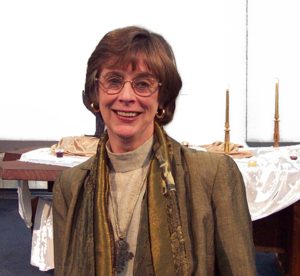The Eighteenth Sunday after Pentecost (Proper 23-C), 13 October 2019
October 13, 2019 | by Marjorie Suchocki
| Reading 1 | Reading 2 | Reading 3 | Reading 4 | Reading 1 Alt | Reading 2 Alt |
|---|---|---|---|---|---|
| Jeremiah 29:1, 4-7 | Psalm 66:1-12 | 2 Timothy 2:8-15 | Luke 17:11-19 | 2 Kings 5:1-3, 7-15c | Psalm 111 |
Our focus for each Sunday this month will be on the gospel texts. Each of these selections tell stories that are well known to most parishioners. Turn that to your advantage by telling the story, not just reading it. I’ve tried to model that for you by telling each of the four stories as if to an audience.
~ Marjorie Suchocki
Again we have a familiar story: the ten lepers. Ten are healed, but only one returns to give thanks. The location of this event is a sort of in-between place, the passage between Samaria and Galilee. This is a sort of no-man’s-land that is both/and, but also neither/nor. Its identity is in flux by virtue of being used as a sort of “Passing lane” from hostile territories where neither side really trusts the other. Jesus and the disciples are in this “in between land” where they see the familiar sight: ten persons afflicted with leprosy, a skin disease that renders them unclean outcasts. Scholars tell us that the disease called leprosy in the Bible is not the Hansen’s disease we know, but a lesser disease given the same name. It results in an ugly sickness of the skin; to contract it is to lose everything — your family, your place in society, your work, society itself. You become outcast, and your only companions are those who suffer the same disease. Finally, you are required to have a bell that you ring to warn healthy persons away from you — biblical leprosy is as lonely a disease as its contemporary cousin, Hansen’s disease.
And so this passageway between rivalries and hostilities, this “no- man’s-land” where one travels as quickly as one can to get someplace else, is nonetheless inhabited — there is a small village clinging to the inbetweeness of the place, and there are, of course, the wandering outcasts, the lepers. They see and recognize Jesus as he approaches the village: “Jesus, master, have mercy on us!” He sees them. Hasn’t he always “seen” them? Isn’t he like that banquet giver of those earlier chapters, who indeed sees — and invites? We all know how the story unfolds, of course: he prescribes the traditional formula for anyone who has recovered from this disease: go and show yourselves to the priest. And the wonder happens: as they obey, they suddenly experience healing — the open sores close, scar, and disappear! The redness melts away! The limping legs become strong — in obeying Jesus, his mercy has indeed encompassed them! They are healed!
Everyone remembers the denouement of the story: one — and only one — returns. He is glorifying God with a loud voice, and as soon as he gets to Jesus he falls on his face, weeping his thanks, his gratitude, scarce daring to believe the miracle that this One has healed him. “And he was a Samaritan,” says the text. The words are stark, but loaded with implication. It is not only the one who is outcast by virtue of his illness who has returned to give thanks, it is also the one so frequently disparaged by Jews as a Samaritan, despised, “other” to proper Jews, The Samaritan is tainted from birth by Gentile blood because of the occupation of Samaria by the Chaldeans, the Babylonians, and whatever occupier came along. Racial animosity, religious animosity, geographical animosity separates Jew from Samaritan, and Jewish purity must not be sullied by Samaritan impurity.
Is it only an ancient dilemma, an ancient story, surpassed by civilization in the times since? Don’t we in America increasingly find ourselves in a passageway, a no-man’s-land, divided by hostilities, hardly a home anymore, but a place on the other side of home, surrounded by those we call “other”? We “name” the “others,” try to keep our distance from them, and lock our doors at night or even keep guns handy so as to kill anyone who might attempt entry! Instant death is only too good for anyone attempting to invade my space, bridge my defenses, take my “stuff.” But in all these Lucan stories, it is precisely the “other” who is close to the heart of God. Ah, the story rings out still, shocking despite its familiarity: the love and grace and healing power of God flows to those we call “other” in every culture in every time, perhaps especially our own. “Behold,” concludes Jesus — surprisingly? — “the kingdom of God is in your midst.” Really? In the one I despise, or the one I fear, in the one whose color, whose language, offends me? And the ever-so-familiar story becomes the frightening challenge to dare the passageway, to enter the space of in-between, and look for the Samaritan in our midst. Expect healing.
Marjorie Hewitt Suchocki is Professor Emerita, Claremont School of Theology, Faculty Co-Director Emerita of the Center for Process Studies, Director Emerita of Process and Faith, and the founder and former Director of the Common Good International Film Festival (formerly, Whitehead International Film Festival). Among her many books are God Christ Church: A Practical Guide to Process Theology; The End of Evil: Process Eschatology in Historical Context; The Whispered Word: A Theology for Preaching; In God’s Presence: Theological Reflections on Prayer; and Through a Lens Darkly: Tracing Redemption in Film.

